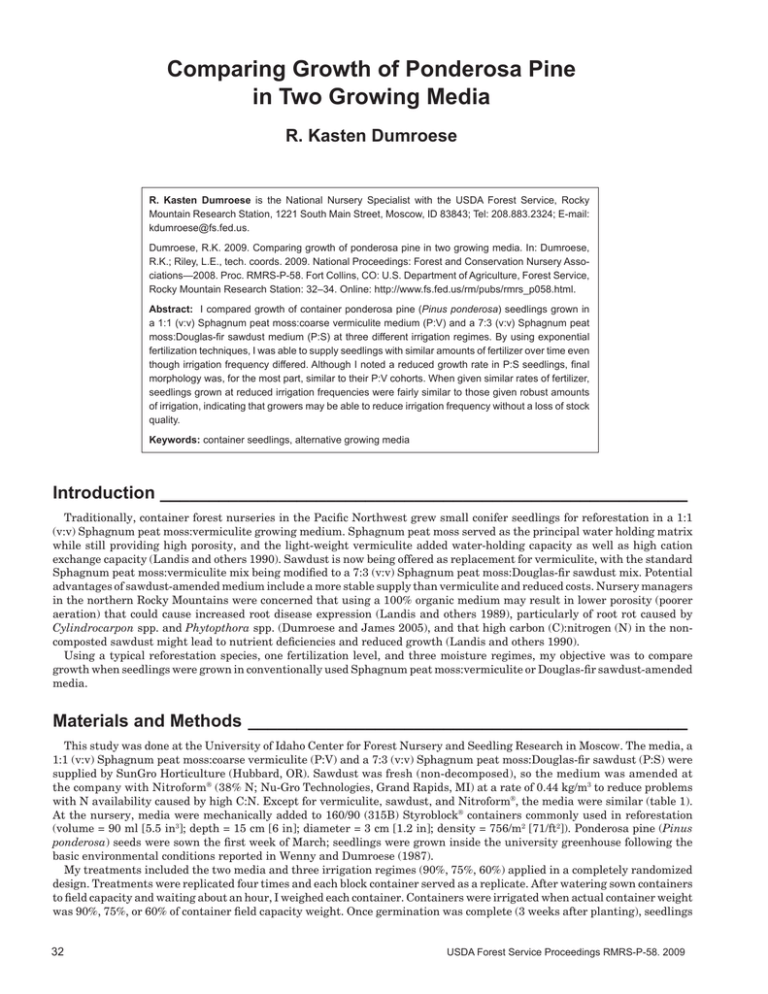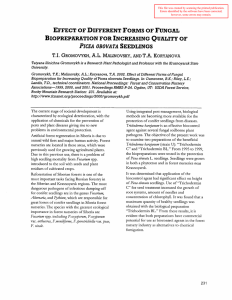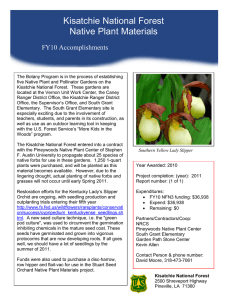Comparing Growth of Ponderosa Pine in Two Growing Media R. Kasten Dumroese
advertisement

Comparing Growth of Ponderosa Pine in Two Growing Media R. Kasten Dumroese R. Kasten Dumroese is the National Nursery Specialist with the USDA Forest Service, Rocky Mountain Research Station, 1221 South Main Street, Moscow, ID 83843; Tel: 208.883.2324; E-mail: kdumroese@fs.fed.us. Dumroese, R.K. 2009. Comparing growth of ponderosa pine in two growing media. In: Dumroese, R.K.; Riley, L.E., tech. coords. 2009. National Proceedings: Forest and Conservation Nursery Associations—2008. Proc. RMRS-P-58. Fort Collins, CO: U.S. Department of Agriculture, Forest Service, Rocky Mountain Research Station: 32–34. Online: http://www.fs.fed.us/rm/pubs/rmrs_p058.html. Abstract: I compared growth of container ponderosa pine (Pinus ponderosa) seedlings grown in a 1:1 (v:v) Sphagnum peat moss:coarse vermiculite medium (P:V) and a 7:3 (v:v) Sphagnum peat moss:Douglas-fir sawdust medium (P:S) at three different irrigation regimes. By using exponential fertilization techniques, I was able to supply seedlings with similar amounts of fertilizer over time even though irrigation frequency differed. Although I noted a reduced growth rate in P:S seedlings, final morphology was, for the most part, similar to their P:V cohorts. When given similar rates of fertilizer, seedlings grown at reduced irrigation frequencies were fairly similar to those given robust amounts of irrigation, indicating that growers may be able to reduce irrigation frequency without a loss of stock quality. Keywords: container seedlings, alternative growing media Introduction_______________________________________________________ Traditionally, container forest nurseries in the Pacific Northwest grew small conifer seedlings for reforestation in a 1:1 (v:v) Sphagnum peat moss:vermiculite growing medium. Sphagnum peat moss served as the principal water holding matrix while still providing high porosity, and the light-weight vermiculite added water-holding capacity as well as high cation exchange capacity (Landis and others 1990). Sawdust is now being offered as replacement for vermiculite, with the standard Sphagnum peat moss:vermiculite mix being modified to a 7:3 (v:v) Sphagnum peat moss:Douglas-fir sawdust mix. Potential advantages of sawdust-amended medium include a more stable supply than vermiculite and reduced costs. Nursery managers in the northern Rocky Mountains were concerned that using a 100% organic medium may result in lower porosity (poorer aeration) that could cause increased root disease expression (Landis and others 1989), particularly of root rot caused by Cylindrocarpon spp. and Phytopthora spp. (Dumroese and James 2005), and that high carbon (C):nitrogen (N) in the noncomposted sawdust might lead to nutrient deficiencies and reduced growth (Landis and others 1990). Using a typical reforestation species, one fertilization level, and three moisture regimes, my objective was to compare growth when seedlings were grown in conventionally used Sphagnum peat moss:vermiculite or Douglas-fir sawdust-amended media. Materials and Methods______________________________________________ This study was done at the University of Idaho Center for Forest Nursery and Seedling Research in Moscow. The media, a 1:1 (v:v) Sphagnum peat moss:coarse vermiculite (P:V) and a 7:3 (v:v) Sphagnum peat moss:Douglas-fir sawdust (P:S) were supplied by SunGro Horticulture (Hubbard, OR). Sawdust was fresh (non-decomposed), so the medium was amended at the company with Nitroform® (38% N; Nu-Gro Technologies, Grand Rapids, MI) at a rate of 0.44 kg/m3 to reduce problems with N availability caused by high C:N. Except for vermiculite, sawdust, and Nitroform®, the media were similar (table 1). At the nursery, media were mechanically added to 160/90 (315B) Styroblock® containers commonly used in reforestation (volume = 90 ml [5.5 in3]; depth = 15 cm [6 in]; diameter = 3 cm [1.2 in]; density = 756/m2 [71/ft2]). Ponderosa pine (Pinus ponderosa) seeds were sown the first week of March; seedlings were grown inside the university greenhouse following the basic environmental conditions reported in Wenny and Dumroese (1987). My treatments included the two media and three irrigation regimes (90%, 75%, 60%) applied in a completely randomized design. Treatments were replicated four times and each block container served as a replicate. After watering sown containers to field capacity and waiting about an hour, I weighed each container. Containers were irrigated when actual container weight was 90%, 75%, or 60% of container field capacity weight. Once germination was complete (3 weeks after planting), seedlings 32 USDA Forest Service Proceedings RMRS-P-58. 2009 Comparing Growth of Ponderosa Pine in Two Growing Media Dumroese Table 1. Media characteristics as supplied by manufacturer. Ingredients Peat moss:vermiculite (P:V) Peat moss:sawdust (P:S) Canadian Sphagnum peat moss Canadian Sphagnum peat moss Coarse vermiculite Douglas-fir sawdust Nitroform® 0.44 kg/m3 pH 3.8 to 4.2 3.5 to 3.9 Soluble salts 0.06 to 0.08 mmho/cm 0.1 to 0.15 mmho/cm Bulk density 0.2 g/cm3 0.2 g/cm3 - -- -- -- -- -- -- -- -- -- -- -- -- -- -- -- -- -- -- -- -- -- -- -- -- -- -- -- -- -- -- -- -- -- -- -- -- -- -- -- -- -- -- -- -- Nutrient — ppm — — ppm — N P K Ca Mg 5 to 10 1 to 5 5 to 10 5 to 10 1 to 6 were fertilized each time they were irrigated (fertigation). I modified the basic nursery regime of Wenny and Dumroese (1987) so seedlings in each treatment combination received 40 mg N applied exponentially during the growing season following the general methods of Timmer and Aidelbaum (1996). By using the exponential fertilizer equations, I could assume a daily fertilizer application frequency and calculate a daily fertilizer amount. For each subsequent fertigation event, the necessary amount of fertilizer (cumulative daily amounts since the prior irrigation) was diluted in the calculated amount of water required to recharge the medium to field capacity weight. When fertigated, containers were placed into a metal tray and watered from above with a watering can. Excess water that accumulated in the tray was collected and reapplied. Thus, I was able to give each treatment an equivalent amount of fertilizer per unit of time. Every 6 weeks after germination was complete, I systematically collected 20 seedlings from each replicate and measured height (top of medium to tip of growing point or terminal bud), root-collar diameter (RCD) 5 mm above the medium, and shoot and root biomass after drying at 60 °C (140 °F) to constant weight. Using the general linear model (PROC GLM; SAS Institute Incorporated, Cary, NC), my model statements for seedling parameters included irrigation regime, medium, and the interaction (alpha = 0.05). When P < 0.05, means were separated using Tukey’s HSD. Results________________________ In general and for all irrigation regimes combined, seedling morphology was similar in both media. P:S yielded seedlings with 5% more RCD—this 0.16 mm increase was statistically significant (P = 0.02) although perhaps not biologically so. Seedlings growing in P:S also had significantly higher root (P = 0.005) and shoot N (P = 0.0002) concentrations, about 9% and 18% more, respectively. Irrigation regime had surprisingly few effects on seedling growth. For both media combined, seedlings grown at a 60% block weight had significantly (P = 0.001) less height growth (about 1.5 cm [0.6 in] less than those grown at 75% and 2.5 cm [1 in] less than those at 90%). Shoot biomass, USDA Forest Service Proceedings RMRS-P-58. 2009 5 to 10 1 to 5 1 to 5 5 to 10 1 to 5 however, was borderline for significance (P = 0.052), with the 60% and 75% treatments having 12% less biomass than the 90% treatment. Root N concentration was 13% less in the 60% treatment, significantly (P = 0.01) less than seedlings receiving more frequent irrigation. Root biomass was the only parameter affected (P = 0.001) by a medium x irrigation interaction. Seedlings grown at a 60% irrigation regime in both media had a higher mean root biomass than those grown at 75%. Regardless of medium across all irrigation frequencies, seedling heights and RCDs followed similar trends throughout the growing season (fig. 1), although height growth in the P:S medium was significantly less than that of the P:V medium for a portion of the rapid growth phase. Irrigation frequency was significantly reduced by target container weight (P = 0.0001), but not by medium (P = 0.12). To maintain 90% target container weight, irrigation was required every 2.1 days, significantly more than the 4.6 days for 75% target container weight that was significantly more than the 7.8 days for 60% target container weight. Irrigating at these frequencies maintained containers at 89%, 76%, and 61% target container weight, respectively. Discussion_____________________ At the onset of the production cycle, the P:S had a higher C:N than the P:V medium. In general, when C:N >20:1, microorganisms use the available N for growth and reproduction, making it unavailable for immediate use by plants. As the carbon sources are depleted, the microorganisms gradually die, and the N stored in their cells is released back into the system. At this point, the N becomes available for plant use (see Landis and Morgan 2009). To circumvent this decrease in early growth caused by N limitation (immobilization) due to high C:N, Nitroform® was added to the P:S medium. Even so, I noted a decrease in the early growth rate in the P:S compared to the P:V medium (fig. 1). Toward the end of the growing season, however, seedling growth in P:S “caught up” to that of seedlings in P:V, probably because the N in the Nitroform® was being released through the death of the microorganisms. The P:S and P:V seedlings were fertilized with 40 mg N, but the P:S seedlings had access to more N 33 Dumroese Comparing Growth of Ponderosa Pine in Two Growing Media Figure 1. Height and root-collar diameter growth of ponderosa pine seedlings growing in 1:1 (v:v) Sphagnum peat moss:coarse vermiculite (P:V) or a 7:3 (v:v) Sphagnum peat moss:Douglas-fir sawdust (P:S) medium, pooled across irrigation treatments. Julian date 110 was April 19, about 6 weeks after sowing, and Julian date 275 is October 1. because of the additional Nitroform®, leading to the higher N concentrations in roots and shoots of seedlings grown in P:S. Seedlings grown under the 90% and 75% block weight regimes were similar in morphology, indicating that final seedling parameters need not be sacrificed by reduced irrigation frequency, provided that similar amounts of N are applied. Growers may be able to better schedule irrigation frequency (and potentially redistribute employee work loads) by irrigating when seedlings reach lower block weights. Reduced irrigation frequency could also mitigate expression of foliar diseases. The reduced early growth I observed concurs with observations by Justin (2009) and those reported by Davis and others (2009), but similarity in final seedling size between the two media concurs with observations by Schaefer (2009). I detected no real differences in water-holding capacity (based on frequency of containers achieving target dry-down block weights), which agrees with Schaefer (2009). It appears that the P:S medium is an appropriate replacement for P:V. For best results, growers must track seedling growth, compare growth rates with target curves, and adjust fertility to keep the crop growing properly—the same process any good grower uses routinely. References_____________________ Davis AS, Eggleston K, Pinto JR, Dumroese RK. 2009. Evaluation of three growing media substrates for Western larch seedling production at thte USDA Forest Service Coeur d'Alene Nursery. In: Dumroese, R.K.; Riley, L.E., tech. coords. 2009. National Proceedings: Forest and Conservation Nursery Associations—2008. Proc. RMRS-P-58. Fort Collins, CO: U.S. Department of Agriculture, Forest Service, Rocky Mountain Research Station:37–41. Dumroese RK, James RL. 2005. Root diseases in bareroot and container nurseries of the Pacific Northwest: epidemiology, management, and effects on outplanting performance. New Forests 30:185–202. Justin J. 2009. Growing media trials at the Montana Conservation Seedling Nursery. In: Dumroese, R.K.; Riley, L.E., tech. coords. 2009. National proceedings: Forest and Conservation Nursery Associations—2008. Proc. RMRS-P-58. Fort Collins, CO: U.S. Department of Agriculture, Forest Service, Rocky Mountain Research Station:42–43. Landis TD, Tinus RW, McDonald SE, Barnett JP. 1989. The container tree nursery manual. Volume 5, the biological component. Washington (DC): USDA Forest Service. Agricultural Handbook. 674. Landis TD, Tinus RW, McDonald SE, Barnett JP. 1990. The container tree nursery manual. Volume 2, containers and growing media. Washington (DC): USDA Forest Service. Agricultural Handbook. 674. Landis TD, Morgan N. 2009. Growing media alternatives for forest and native plant nurseries. In: Dumroese, R.K.; Riley, L.E., tech. coords. 2009. National proceedings: Forest and Conservation Nursery Associations—2008. Proc. RMRS-P-58. Fort Collins, CO: U.S. Department of Agriculture, Forest Service, Rocky Mountain Research Station:26–31. Schaefer JK. 2009. Growing reforestation conifer stock: UtiliΩing peat/sawdust medium. In: Dumroese, R.K.; Riley, L.E., tech. coords. 2009. National proceedings: Forest and Conservation Nursery Associations—2008. Proc. RMRS-P-58. Fort Collins, CO: U.S. Department of Agriculture, Forest Service, Rocky Mountain Research Station:35-36. Timmer VR, Aidelbaum AS. 1996. Manual for exponential nutrient loading of seedlings to improve outplanting performance on competitive forest sites. Sault Ste Marie (ON): Canadian Forest Service. NODA/NFP Tech. Rep. TR-25. 24 p. Wenny DL, Dumroese RK. 1987. A growing regime for containerized ponderosa pine seedlings. Moscow (ID): University of Idaho, Idaho Forest, Wildlife, and Range Experiment Station. Bulletin 43. The content of this paper reflects the views of the authors, who are responsible for the facts and accuracy of the information presented herein. 34 USDA Forest Service Proceedings RMRS-P-58. 2009




